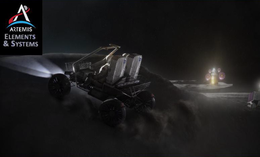Lunar Terrain Vehicle
 Artist's impression the Lunar Terrain Vehicle on the lunar surface | |
| Names | Lunar Terrain Vehicle (LTV) |
|---|---|
| Operator | NASA |
The Lunar Terrain Vehicle (LTV) is an unenclosed rover being developed by NASA that astronauts can drive on the Moon while wearing their spacesuits. The development of the LTV is a part of NASA's Artemis Program which involves returning astronauts to the Moon, specifically the lunar south pole, by 2025. The Lunar Terrain Vehicle will be the first lunar rover developed by NASA since the Lunar Roving Vehicle used during the Apollo program.
History[]
On February 6, 2020, NASA issued a request to seeking industry feedback on relevant state-of-the-art commercial technologies and acquisition strategies for a new Lunar Terrain Vehicle. NASA also stated in the request that they want the new LTV to draw on recent innovations in electric vehicle energy storage and management, autonomous driving, and extreme environment resistance.”[1]
On August 31, NASA released another request to private companies for additional input on approaches and solutions for a vehicle to transport Artemis astronauts around the lunar South Pole. NASA also asked if American companies are interested in providing the LTV as a commercial service, or as a product NASA would purchase and own.[2]
LTV Proposals[]
Two proposals for a Lunar Terrain Vehicle have been publicly unveiled since NASA's initial request.
- On May 26, 2021, Lockheed Martin and General Motors announced they would be teaming up to design a Lunar Terrain Vehicle (LTV) for NASA capable of transporting astronauts across the lunar surface.[3]
- On November 16, 2021, Northrop Grumman announced they would team up with AVL, Intuitive Machines, Lunar Outpost, and Michelin to design a Lunar Terrain Vehicle (LTV) to transport NASA’s Artemis astronauts around the lunar surface.[4]
Plans[]
NASA currently plans to launch the Lunar Terrain Vehicle on Artemis 5. The Lunar Terrain Vehicle will be a co-manifested payload on a Space Launch System Block 1B rocket in which the rover will ride on the Exploration Upper Stage right below the Orion spacecraft.[5]
See also[]
- Lunar Roving Vehicle, the 1970s Apollo program equivalent used on Apollo 15, 16, and 17
- Space Exploration Vehicle, previous NASA concept for a multipurpose rover
References[]
- ^ "NASA to Industry: Send Ideas for Lunar Rovers". NASA. February 6, 2020. Retrieved February 14, 2022.
- ^ "NASA Prompts Companies for Artemis Lunar Terrain Vehicle Solutions". NASA. August 31, 2021. Retrieved December 3, 2021.
- ^ "Lockheed Martin, General Motors Team Up to Develop Next-Generation Lunar Rover for NASA Artemis Astronauts to Explore the Moon". media.gm.com. November 16, 2021. Retrieved December 3, 2021.
- ^ "Northrop Grumman Announces Team for NASA's Next-Generation Lunar Terrain Vehicle". news.northropgrumman.com. November 16, 2021. Retrieved December 3, 2021.
- ^ Foust, Jeff (20 January 2022). "NASA foresees gap in lunar landings after Artemis 3". SpaceNews. Retrieved 2 February 2022.
- Lunar rovers
- Missions to the Moon
- 2025 in spaceflight
